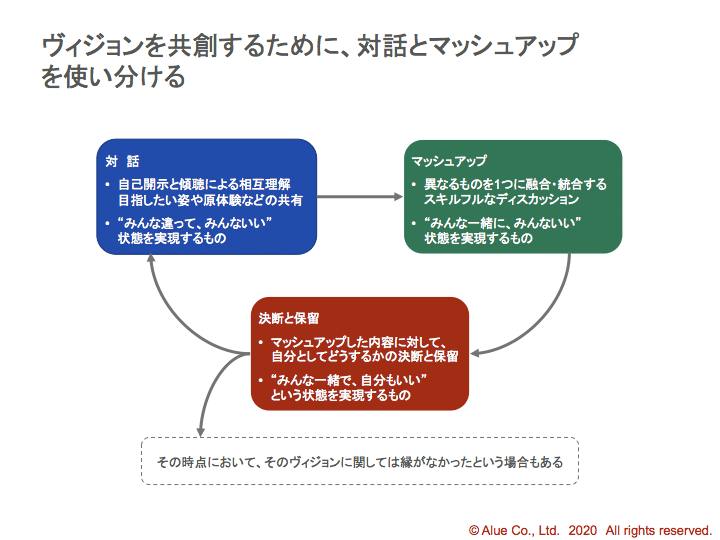
どうすれば、一人ひとりがヴィジョンとのつながりを持てるのか?(ヴィジョンの構想プロセス③)
前回ならびに前々回の記事において、ヴィジョンの構想プロセスについてお話しをしてきました。これまでの内容をまとめると次のようになります。
ヴィジョンの構想プロセス(途中まで)
①主体的真理から始める
②意識の自然な流れと、意識の偏在のギャップに注目する
③問いを立て、直感を活用する
今回の記事では、このヴィジョンの構想プロセスの最後のポイントについてお話しします。
上記の①〜③のプロセスは個人で行うプロセスになりますが、個人で構想したヴィジョンあるいは、ヴィジョンの元となる直感をもとに、チームで共創するプロセスが最後のポイントになります。
人は完璧なヴィジョンを求めていない
もし、みなさんがチームリーダーから、次のように伝えられたらどのように思うでしょうか?
私が考えた素晴らしいヴィジョンがある。このヴィジョンは、世の中の多くの人の生活を向上させるものだ。このヴィジョンを実現することで、世の中の多くの人の役に立つだけではなく、それに関わるみなさんも大いなるやりがいをもてるだろう。
このヴィジョンの実現には14のプロセスがある。そして、このプロセスの完遂に必要な機能は9、すなわち9つのチームが協働していく必要がある。それぞれのプロセスには、50-100の業務手順が定義されており、それを実行すればこのヴィジョンが実現できるプランになっている。

いかがでしょうか?このチームに参画して、一緒にヴィジョン実現をしたいと思うでしょうか?
おそらく、「ここまで計画立てることができるのは素晴らしいけど、自分が関わることの意味があまり理解できず、ワクワクしない」というような感想をもつのではないでしょうか。
リーダーの立場になると、「ヴィジョンはリーダーが掲げるべき」というようなべき論に捉われて、全部自分一人で考え、なるべく完璧なヴィジョンを設定しなければいけないと思ってしまうことがあります。
しかし、人は完璧なヴィジョンを求めていません。
ヴィジョンを構想するという段階であれば、誰かが自分で考えたヴィジョンを与えられるのではなく、一緒に創るというプロセスに参画できることを求める人が多いのではないでしょうか。
すでにヴィジョンがある場合であっても、そのヴィジョンには奥行きや広がりがあることで、自分がやりたいこと、ありたい姿、主体的真理と重ね合わせる余地を求めているのではないでしょうか。
ヴィジョンは与えるものでも、与えられるものでもなく、共創するもの
これまでお話しした冒頭の①〜③のヴィジョン構想プロセスは、個人の中で進めていくプロセスでした。そこで直感したヴィジョンがそのままチームのヴィジョンになるわけではありません。
チームに参画するそれぞれの人が、①〜③の構想プロセスで捉えた自分なりの直感やヴィジョンの種をもとに、チームとしてのヴィジョンを共創するのが、最後のプロセスになります。

チームとしてのヴィジョンを共創することで、もともとの一人ひとりの直感やヴィジョンの種とは異なるかもしれませんが、一人ひとりが自分の主体的真理とのつながりを感じられるチームの共有ヴィジョンを導出することができます。
繰り返しになりますが、ヴィジョンを共創するというのは、ヴィジョンを構築する段階であっても、既にあるヴィジョンを再解釈するという場面であっても変わりません。
既にヴィジョンが存在するという場合は、一人ひとりの直感やヴィジョンの種をもとに、既にあるヴィジョンを再解釈するということになります。チームのヴィジョンに奥行きや広がりがあって、一人ひとりがチームのヴィジョンを再解釈する余地があり、それぞれの解釈を共有できる場があれば、ヴィジョンを共創していると捉えることができます。
どちらの場合も、一人ひとりの主体的真理につながった直感やヴィジョンの種を持ち寄って、重ね合わせをしていくことは共通しているからです。
対話とマッシュアップによってヴィジョンを共創する
ヴィジョンを共創するためには、対話とマッシュアップを使いわけることが大切になります。
対話とは、自己開示と傾聴による相互理解を促進するものであり、一人ひとりの目指したい姿や原体験などについて言語化されたものだけではなく、非言語的なものを含めて共有するプロセスです。「みんな違って、みんないい」という状態を実現するためのものと言えます。
マッシュアップとは、もともとは音楽業界で使われていた言葉で、異なるものを1つに融合・統合することによって創造するという意味があります。ヴィジョンの共創においても、一人ひとりの異なる思いを1つに融合・統合するスキルフルなディスカッションのことを指します。「みんな一緒に、みんないい」という状態を実現するためのものと言えます。

対話をしながら相互理解を進めていき、違いを違いとして認めながら、マッシュアップによって、全員で共通して目指していきたいヴィジョンを描いていきます。既にヴィジョンがあるという状況であれば、対話による相互理解をしながら、ヴィジョンをどのように解釈することで、一人ひとりの主体的真理につながったものとして捉えることができるかをディスカッションするというイメージになります。

そして、対話とマッシュアップは一方通行ではなく、何度も行き来します。マッシュアップによって共通する部分を見出しながら、人によって違う部分は、その違いがどのような経験や価値観からくるのかを対話によって相互理解を深めます。相互理解が進むと、最初は違いと認識していたものが、実は共通する部分がありそうという発見につながり、再びマッシュアップに戻ったりします。
このような対話とマッシュアップをベースとしながらも、実はもう一つ「決断と保留」という要素があります。これはマッシュアップした内容に対して、自分としてどのように関わるかについての決断と保留という要素です。この要素があることによって、一人ひとりの主体的真理とのつながりを捨象せずに、「みんな一緒で、自分(一人ひとり)もいい」という状態を実現することができます。
決断の内容によっては、「その時点においては、そのヴィジョンの実現には参画しない」ということもあるかもしれません。チームメンバーになる予定の人が離れていってしまうことは寂しい気持ちがしますが、その人の主体的真理を大切にするという観点から言えば、そのような決断をする個人とチームを尊重したくなるのは私だけでしょうか。
対話とマッシュアップの使い分けについてお話ししてきましたが、私自身の例を用いて、もう少し具体的なイメージをご説明したいと思います。その例として挙げたいのは、この記事で書いている内容を探求してきた「意識の意識化」プロジェクトです。このプロジェクトは、最初から最後まで(そして、今も!)対話とマッシュアップの連続であったといっても過言ではありません。
対話という面でいえば、それぞれの生い立ち、家庭環境、大学時代に熱中したこと(これはテニスサークルで一緒だったので既に共有されていました)、社会人になってからの葛藤のストーリーなど、様々なことについて対話をして相互理解を深めていきました。
それと同時に、探求した内容をアウトプットするときには、侃侃諤諤のスキルフルディスカッションをします。議論がヒートアップして夜遅くまでディスカッションしたこともありますし、チャットのやりとりが1日で100往復くらいしたこともあります。
このような対話とマッシュアップの繰り返しによって、「意識の意識化」プロジェクトを通じて目指す世界を共有することができましたし、その世界に向けたアウトプットも結晶化することができました。
そして、幸いながら、初期メンバー3人が最後まで抜けることなく完遂することができました。換言すれば、一人ひとりの主体的真理とのつながりを感じ続けることができ、このプロジェクトに参画し続けるという決断をし続けることができたと言えます。
ここまでヴィジョンの構想プロセスの終盤となる「ヴィジョンの共創」についてお話ししてきました。これまでの内容をまとめると次のようになります。
ヴィジョンの構想プロセス
① 主体的真理から始める
② 意識の自然な流れと、意識の偏在のギャップに注目する
③ 問いを立て、直感を活用する
④ 対話とマッシュアップによって、ヴィジョンを共創する
本日の問いとなります。(よろしければ、コメントにご意見ください)
・あなたのこれまでの経験で、対話とブラッシュアップがうまく使い分けられていたチームプロセスがあったとすれば、それはどのようなプロセスでしたか?
・そのチームプロセスに参画することは、あなたにとって日々どのような感情・思いを抱かせるものでしたか?
How can each individual be connected to the team vision?(Visioning process (3))
In the last two articles, I have talked about the visioning process. The following is a summary of what we have done so far.
Visioning process (halfway through)
(1)Start with subjective truth
(2)Focus on the gap between the natural flow of consciousness and the partiality of consciousness
(3)Develop "quests" and use one' s intuition
In this article, I will discuss the last point in this visioning process.
The above processes (1) through (3) are individual processes, but the last point is the process of co-creation by a team based on the vision or intuition that is the basis of the vision that was conceived by the individuals.
People don't expect to have perfect visions
How would you feel if the leader of your team told you the following?
I have a wonderful vision. This vision is to improve the lives of many people in the world. The realization of this vision will not only help many people in the world, but will also be very rewarding for everyone involved.
There are 14 processes involved in realizing this vision. The number of functions required to complete these processes is 9, which means that 9 teams need to work together. For each process, 50 to 100 business procedures are defined, and by executing them, the vision can be realized.
What do you think? Do you want to join this team and work together to realize this vision?
Perhaps you feel that it's great that the team leader can plan so well, but you don't really understand the significance of your involvement, and it doesn't excite you.
When we are in a leadership position, we sometimes get caught up in the belief that the leader should be the one to set the vision, and we think that we have to think of everything by ourselves and set the vision as perfect as possible.
However, people don't expect to have perfect visions.
If we are at the stage of envisioning a vision, I think many people would like to be able to participate in the process of creating it together, rather than being given a vision that someone else came up with.
Even in cases where we already have a vision, many people may want that vision to have depth and breadth so that they have room to overlap it with what they want to do, be, and their subjective truth.
Vision is not something to give or be given, but something to co-create
The visioning process that I have described so far, from (1) to (3), was a process that was carried out by individuals. The vision that we have intuited does not automatically become the vision of the team.
The final process is for each person on the team to co-create a vision for the team based on their own intuition and the seeds of their vision captured in the conceptualization process (1) through (3).
By co-creating a vision as a team, we can derive a shared vision for the team that may not be the same as each person's original intuition or seed of vision, but that each person can feel connected to their own subjective truth.
Again, co-creating a vision is the same whether we are building a vision or reinterpreting an existing vision.
When a vision already exists, it means that each person is reinterpreting an existing vision based on their own intuition and the seeds of the vision. If the team's vision has depth and breadth, and if there is room for each person to reinterpret the team's vision, and if there is a place where each person can share his or her interpretation, then the team is co-creating the vision.
This is because in both cases, it is common to bring the seeds of intuition and visions connected to each person's subjective truth and to overlay them.
Co-creating visions through dialogue and mashups
In order to co-create a vision, it is important to use both dialogue and mashup.
Dialogue is a process to promote mutual understanding through self-disclosure and active listening, and to share not only verbal but also non-verbal information about each person's aspirations and personal experiences. It is a way to realize the state of "Everyone is different and everyone is okay."
Mashup is a word originally used in the music industry, meaning to create by merging and integrating different things into one. In co-creating a vision, it also refers to a skillful discussion to fuse and integrate the different thoughts of each person into one. It is a way to achieve the state of "We're all in this together and everyone is okay."
While promoting mutual understanding through dialogue and acknowledging differences as differences, we create a common vision that we all want to achieve through mash-up. If we already have a vision, we can discuss how we can interpret the vision in a way that is connected to each person's subjective truth, while promoting mutual understanding through dialogue.

Dialogue and mashups are not a one-way process; they go back and forth many times. While finding common ground through mashups, we deepen our mutual understanding of the differences between people through dialogue to understand how those differences come from their experiences and values. As mutual understanding progresses, what was initially perceived as a difference may actually lead to the discovery that there may be something in common, and the process of mashup returns.
While based on this kind of dialogue and mashup, there is actually another element called " make decisions or hold decisions". This is the element of deciding or holding back on how one will relate to the content of the mashup. This element allows us to achieve the state of " We are all in this together, and I (each of us) am also good" without discarding the connection to the subjective truth of each individual.
Depending on the content of the decision, it may be that the person will not participate in the realization of the vision at that point in time. It is a sad feeling when a person who is going to be a team member leaves, but from the perspective of valuing the subjective truth of that person, am I the only one who would want to respect the individual and the team who makes such a decision?
I have talked about the use of dialogue and mashups, and I would like to use my own example to give you a more concrete picture. An example of this is the ISHIKI(Consciousness) Management project, which has explored what I am writing about in my articles. It is no exaggeration to say that this project was (and still is!) a series of dialogues and mashups from beginning to end.
In terms of dialogue, we deepened our mutual understanding by talking about various things, such as each person's upbringing, family environment, what they were passionate about in university ( this was already shared with us since we were in a tennis club together), and the story of our struggles after entering the workplace.
At the same time, when we output what we have explored, we have skillful and controversial discussions. There have been times when discussions have become so heated that we have stayed up late into the night, and there have been times when we have exchanged about 100 rounds of chat in one day.
Through these repeated dialogues and mashups, we were able to share the worldview we were aiming for through the ISHIKI(Consciousness) Management project, and we were able to crystallize the output to realize that worldview.
And, fortunately, the three initial members were able to complete the project without leaving until the end. In other words, we were able to continue to feel the connection with each individual's subjective truth and to make the decision to continue participating in this project.
So far, we have talked about "co-creation of vision," which is the final stage of the visioning process. The following is a summary of what we have covered so far.
Visioning process
(1)Start with subjective truth
(2)Focus on the gap between the natural flow of consciousness and the partiality of consciousness
(3)Develop "quests" and use one' s intuition
(4)Co-creating visions through dialogue and mashups
Here are the quests of the day. (If you'd like, please share your thoughts in the comments.)
・In your past experience, if there was a team process where dialogue and brush-up were well used, what was it?
・How did participating in such a team process make you feel on a daily basis?
Bunshiro Ochiai
この記事が気に入ったらサポートをしてみませんか?
